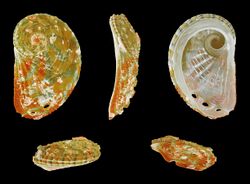Biology:Haliotis clathrata
| Haliotis clathrata | |
|---|---|

| |
| A shell of Abalone clathrata | |
| Scientific classification Error creating thumbnail: Unable to save thumbnail to destination
| |
| Domain: | Eukaryota |
| Kingdom: | Animalia |
| Phylum: | Mollusca |
| Class: | Gastropoda |
| Subclass: | Vetigastropoda |
| Order: | Lepetellida |
| Family: | Haliotidae |
| Genus: | Haliotis |
| Species: | H. clathrata
|
| Binomial name | |
| Haliotis clathrata Reeve, 1846
| |
| Synonyms[2] | |
| |
Haliotis clathrata, common name the lovely abalone, is a species of sea snail, a marine gastropod mollusc in the family Haliotidae, the abalones.[2]
Description
The size of the shell varies between 10 mm and 60 mm. The large, solid but not thick shell has a rounded-oval shape and is much depressed. The distance of the apex measures from the margin one-fifth the length of the shell. The shell is sculptured with fine spiral cords cut by close minute striae of increment and has radiating waves or folds above. A slight angle at the row of perforations, below it is broadly excavated and then carinated. The about six perforations are elevated and circular. The outline is suborbicular and much depressed. The color pattern of the surface is either dark red with few radiating angular white patches, or dull red and green, streaked and mottled. The spiral cords of the outer surface are either nearly equal or have slightly larger ones at wide intervals. They are decussated by close growth-striae. The whorls number a trifle over three. The inner surface is corrugated like the outer surface, silvery, very brilliantly iridescent. The reflections are chiefly sea-green and red. The columellar plate is broad, flat, and obliquely truncated at its base. The cavity of the spire is wide, open, but shallow. This is a variable form, in color varying from dark coral red to dull red streaked with pale green.[3] This species also occurs in a different form: Haliotis clathrata f. tomricei (Patamakanthin, 2002).
The shape of the shell forms a logarithmic spiral with an expansion coefficient of 0.25, which is close to the 0.31 coefficient of a golden spiral, although shells exist with a wide range of coefficients and this proximity is of no particular significance.[4]
Distribution
This marine species occurs in the western Pacific Ocean, on the coasts of including Australia and the islands and mainland of Southeast Asia, as well as islands in the Indian Ocean such as Madagascar and Mauritius and stretches of the East African coast.[1]
References
- ↑ 1.0 1.1 Peters, H. (2021). "Haliotis clathrata". IUCN Red List of Threatened Species 2021: e.T78763614A78772408. doi:10.2305/IUCN.UK.2021-1.RLTS.T78763614A78772408.en. https://www.iucnredlist.org/species/78763614/78772408. Retrieved 19 November 2021.
- ↑ 2.0 2.1 Haliotis clathrata Reeve, 1846. Retrieved through: World Register of Marine Species on 5 October 2010.
- ↑ H.A. Pilsbry (1890) Manual of Conchology XII; Academy of Natural Sciences, Philadelphia, 1890 (described as Haliotis naevosa Martyn)
- ↑ Øyvind Hammer (2016). The Perfect Shape: Spiral Stories. Springer. p. 17. ISBN 9783319473734. https://books.google.com/books?id=BTigDQAAQBAJ&pg=PA17.
- Reeve, L.A. 1846. Descriptions of forty species of Haliotis, from the collection of H. Cumming, Esq. Proceedings of the Zoological Society of London 14: 53–59
- Adams, A. & Reeve, L. 1850. Mollusca. pp. 45–87 in Adams, A. (ed.). The Zoology of the Voyage of H.M.S. Samarang; under the command of Captain Sir Edward Belcher, C.B.F.R.A.S., F.G.S. during the years 1843-1846. London : Reeve, Benham & Reeve Vol. 3.
- Ladd, H.S. in Ladd, H.S. & Hoffmeister, J.E. 1945. The Geology of Lau, Fiji. Bulletin of the Bernice P. Bishop Museum 181: 331–370
- Geiger, D.L. 2000 [1999]. Distribution and biogeography of the recent Haliotidae (Gastropoda: Vetigastropoda) world-wide. Bollettino Malacologico 35(5–12): 57-120
- Geiger D.L. & Poppe G.T. (2000). A Conchological Iconography: The family Haliotidae. Conchbooks, Hackenheim Germany. 135pp 83pls.
External links
- "Haliotis (Haliotis) clathrata" (in en). Gastropods.com. http://www.gastropods.com/2/Shell_21512.shtml.
Wikidata ☰ Q7989581 entry
 |


